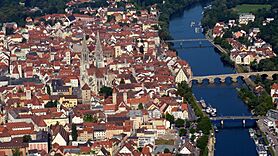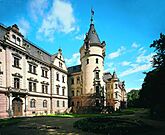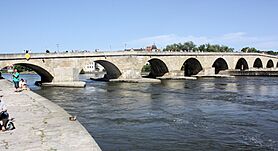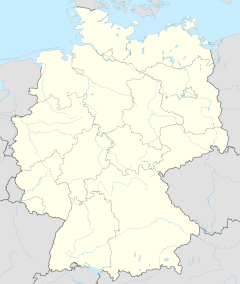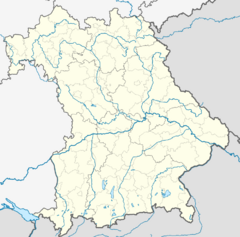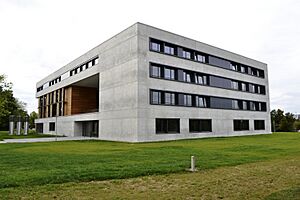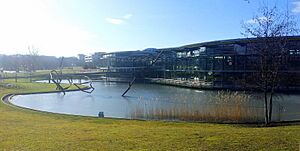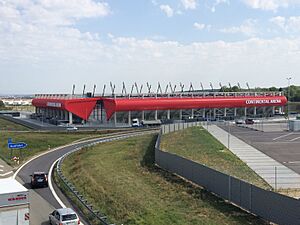Regensburg facts for kids
Quick facts for kids
Regensburg
Rengschburg / Rengschburch (Bavarian)
|
|||
|---|---|---|---|
|
Medieval Centre
Old town hall
Schloss St. Emmeram
Stone Bridge
|
|||
|
|||
| Country | Germany | ||
| State | Bavaria | ||
| District | Urban district | ||
| Subdivisions | 18 districts | ||
| Area | |||
| • Total | 80.76 km2 (31.18 sq mi) | ||
| Population
(2022-12-31)
|
|||
| • Total | 157,443 | ||
| • Density | 1,949.52/km2 (5,049.2/sq mi) | ||
| Time zone | UTC+01:00 (CET) | ||
| • Summer (DST) | UTC+02:00 (CEST) | ||
| Postal codes |
93001–93059
|
||
| Dialling codes | 0941 | ||
| Vehicle registration | R | ||
| Website | www.regensburg.de | ||
| UNESCO World Heritage Site | |||
| Official name | Old town of Regensburg with Stadtamhof | ||
| Criteria | Cultural: ii, iii, iv | ||
| Inscription | 2006 (30th Session) | ||
| Area | 182.8 ha | ||
| Buffer zone | 775.6 ha | ||
Regensburg is a beautiful city in eastern Bavaria, Germany. It sits where three rivers meet: the Danube, Naab, and Regen. This spot is the Danube's northernmost point.
Regensburg is the capital of the Upper Palatinate area. With over 150,000 people, it is the fourth-largest city in Bavaria. Only Munich, Nuremberg, and Augsburg are bigger. It's also the 8th largest city along the Danube river.
From its start as a Roman fort, Regensburg has been a key center for the region. It was important for politics, money, and culture. Later, during the Holy Roman Empire, it was home to the Perpetual Diet of Regensburg, a big meeting of leaders.
The old part of the city is a UNESCO World Heritage Site since 2006. This is because its old buildings are very well kept. It's the largest medieval city area north of the Alps. Its history is also important for the meetings held there during the Holy Roman Empire. In 2014, Regensburg was one of the top places to visit in Germany.
Contents
- History of Regensburg
- Regensburg's Geography and Climate
- Top Sights in Regensburg
- Culture and Entertainment
- Population and Diversity
- Sister Cities Around the World
- Economy and Industry
- City Infrastructure
- Education and Research
- Sports in Regensburg
- Famous People from Regensburg
- Images for kids
- See also
History of Regensburg
Ancient Beginnings: Early Settlements
People first lived in the Regensburg area during the Stone Age. The oldest name for a settlement here was Radasbona, given by the Celts. Around AD 90, the Romans built a fort at this site.
In 179 AD, a new, larger Roman fort was built. It was called Castra Regina, meaning "fortress by the river Regen." This fort was for a Roman army group called Legio III Italica. It was a very important camp at the northernmost bend of the Danube River. Today, this old fort is the heart of Regensburg's Old City. It is believed that a bishop lived in the city even in late Roman times.
Medieval Regensburg: A Capital City
From the early 500s, Regensburg was the home of a ruling family called the Agilolfings. It was the capital of Bavaria from about 530 until the early 1200s. The bishopric (area led by a bishop) that the Romans started was brought back by St Boniface in 739.
Regensburg stayed an important city during the time of Charlemagne in the late 700s. In 792, Charlemagne held a big meeting there. Bishops at this meeting spoke out against a religious idea called adoptionism.
After the Carolingian Empire split in 843, Regensburg became the home of the East Frankish ruler, Louis the German. A few years later, 14 princes from Bohemia came to Regensburg to be baptized. This was the start of Christianity in the Czech lands. Regensburg's diocese became the "mother diocese" for Prague. This had a huge impact on the culture of the Czech lands.
By the year 1000, Regensburg's population grew to 40,000 people. In 1096, during the First Crusade, some crusaders tried to force Jewish people in Regensburg to convert. They killed those who refused.
Between 1135 and 1146, the famous Stone Bridge was built over the Danube. This bridge helped open up major trade routes between northern Europe and Venice. This began Regensburg's "golden age." It became a center for culture in southern Germany. The city was known for its beautiful gold work and fabrics.
Regensburg as a Free Imperial City
In 1245, Regensburg became a Free Imperial City. This meant it was independent and answered only to the Holy Roman Emperor. It was a big trade center until trade routes changed later in the Middle Ages.
Regensburg was always a place for important international meetings. In 1471, a war against the Turks was discussed here. In 1486, Regensburg became part of the Duchy of Bavaria. But ten years later, the Holy Roman Emperor gave it back its independence.
The city adopted the Protestant Reformation in 1542. Its city council became entirely Lutheran. From 1663 to 1806, Regensburg was the permanent home of the Imperial Diet. This was a meeting of all the leaders of the Holy Roman Empire. This made Regensburg one of the most important cities in the Empire.
Even though the city was Protestant, it remained the home of a Roman Catholic bishop. Several abbeys were also there. Three of these, St. Emmeram, Niedermünster, and Obermünster, were like independent states. They had a say in the Imperial Diet. So, Regensburg was unique. It had five independent "states" within it: the Protestant city, the Catholic bishopric, and three monasteries.
Modern History: Changes and Growth
In 1803, Regensburg lost its status as an imperial city. It became part of the Principality of Regensburg. This was given to Carl von Dalberg, the Archbishop-Elector of Mainz. He brought many modern changes to the city. He also gave equal rights to Protestants and Roman Catholics. In 1810, Regensburg became part of the Kingdom of Bavaria.
From April 19 to 23, 1809, Regensburg was the site of the Battle of Ratisbon. This was a fight between forces led by Napoleon and the Austrian army. The city was badly damaged during this battle. About 150 houses were burned, and others were looted.
World War II and Recovery
During World War II, Regensburg had an aircraft factory and an oil refinery. These were bombed by the Allies. But the city itself did not suffer much damage from the bombings. This is why its medieval city center is still almost fully intact. It is now a World Heritage Site.
After the war, Regensburg recovered slowly. This slow recovery actually helped save its historic buildings. They were not torn down to make way for new ones. By the late 1960s, people wanted to preserve the city's heritage.
Between 1945 and 1949, Regensburg was home to Germany's largest camp for displaced persons. These were people who had been forced from their homes.
In the 1960s, Regensburg worked hard to attract new industries. Siemens was the first big company to come. This was a major step for the city. In 1965, Regensburg University was founded. The Regensburg University of Applied Sciences opened in 1971. In 1986, BMW opened a large car factory. Since the 1990s, many high-tech companies like Infineon and OSRAM have come to Regensburg. This has helped the city become very wealthy.
In 1997, Regensburg won the Europe Prize. This was for its great efforts in bringing Europe closer together. In 2006, the World Heritage Committee named Regensburg's Old Town a UNESCO World Heritage Site.
Regensburg's Geography and Climate
Where is Regensburg Located?
Regensburg is located at the northernmost point of the Danube river. It sits where four different types of landscapes meet:
- To the north and northeast, you'll find the Bavarian Forest. It has granite mountains, large forests, and a national park.
- To the east and southeast is the rich Danube plain, called Gäuboden. This area has very fertile soil.
- The south has rolling hills, which are part of the Alpine Foreland.
- To the west is the Franconian Jura, a hilly region.
Regensburg's Weather: Climate Overview
Regensburg has a climate that is a mix of humid continental and oceanic. The average temperature from 1971 to 2000 was 8.5°C (47.3°F). This is a bit warmer than the German average. However, only 5 out of 80 large German cities are colder.
The city gets about 636 mm (25 inches) of rain each year. This is slightly less than the German average. From 1981 to 2010, the average temperature went up to 8.9°C. Rainfall also increased to 658 mm. Regensburg gets about 1670 hours of sunshine each year. This is about 120 hours more than the German average.
July is usually the warmest month. January is usually the coolest month.
| Climate data for Regensburg (1991–2020 normals) | |||||||||||||
|---|---|---|---|---|---|---|---|---|---|---|---|---|---|
| Month | Jan | Feb | Mar | Apr | May | Jun | Jul | Aug | Sep | Oct | Nov | Dec | Year |
| Mean daily maximum °C (°F) | 2.3 (36.1) |
4.7 (40.5) |
10.3 (50.5) |
16.5 (61.7) |
20.7 (69.3) |
24.2 (75.6) |
26.1 (79.0) |
25.8 (78.4) |
20.3 (68.5) |
13.9 (57.0) |
6.9 (44.4) |
2.9 (37.2) |
14.6 (58.3) |
| Daily mean °C (°F) | −0.4 (31.3) |
0.7 (33.3) |
4.9 (40.8) |
9.7 (49.5) |
14.2 (57.6) |
17.6 (63.7) |
19.3 (66.7) |
18.9 (66.0) |
14.1 (57.4) |
9.0 (48.2) |
4.0 (39.2) |
0.6 (33.1) |
9.4 (48.9) |
| Mean daily minimum °C (°F) | −2.9 (26.8) |
−2.5 (27.5) |
0.5 (32.9) |
3.8 (38.8) |
8.1 (46.6) |
11.7 (53.1) |
13.4 (56.1) |
13.2 (55.8) |
9.2 (48.6) |
5.3 (41.5) |
1.5 (34.7) |
−1.6 (29.1) |
5.0 (41.0) |
| Average precipitation mm (inches) | 48.3 (1.90) |
37.1 (1.46) |
43.6 (1.72) |
35.9 (1.41) |
60.2 (2.37) |
80.0 (3.15) |
76.9 (3.03) |
73.3 (2.89) |
49.9 (1.96) |
49.0 (1.93) |
48.1 (1.89) |
54.3 (2.14) |
660.1 (25.99) |
| Average precipitation days (≥ 1.0 mm) | 16.6 | 14.4 | 14.5 | 11.6 | 14.4 | 14.5 | 15.3 | 13.4 | 12.8 | 14.4 | 14.7 | 17.7 | 174.8 |
| Average snowy days (≥ 1.0 cm) | 14.8 | 13.2 | 3.8 | 0.1 | 0 | 0 | 0 | 0 | 0 | 0 | 2.2 | 8.8 | 42.9 |
| Average relative humidity (%) | 87.3 | 82.8 | 75.9 | 68.8 | 70.3 | 70.7 | 70.5 | 72.3 | 79.4 | 85.9 | 89.8 | 90.1 | 78.6 |
| Mean monthly sunshine hours | 47.6 | 80.1 | 131.2 | 186.5 | 215.7 | 225.6 | 234.4 | 221.2 | 158.6 | 97.5 | 45.0 | 37.8 | 1,681.2 |
| Source: World Meteorological Organization | |||||||||||||
Top Sights in Regensburg
Regensburg has the largest medieval old town north of the Alps. It has almost 1,500 historic buildings. The city looks like a picture from a storybook. Most famous sights are in the Old Town.
Iconic Buildings and Landmarks
- The Dom (Cathedral) is a great example of German Gothic style. It started in 1275 and was mostly finished by 1634. The towers were completed much later, in 1869. Inside, you can see many interesting statues. The famous Regensburger Domspatzen choir sings here.
- The Stone Bridge, built from 1135 to 1146, is an amazing example of medieval bridge building. Knights from the 2nd and 3rd Crusades used it to cross the Danube.
- The Regensburg Sausage Kitchen is a popular spot for tourists and locals. It was first built as a construction office for the Stone Bridge.
- You can still see parts of the Roman fortress walls, including the Porta Praetoria.
- The Church of St. James, also called Schottenkirche, is a Romanesque church from the 12th century. It has unusual carvings on its main doorway.
- The old church of St. Ulrich is a good example of 13th-century style. It holds a valuable collection of old art.
- The Adler-Apotheke is one of Regensburg's oldest pharmacies, founded in 1610. You can see its old interior and historical containers.
- Wealthy families used to compete to build the highest tower. The Goldener Turm (golden tower) was built in 1260.
- The Old Town Hall dates back to the 14th century. It has the rooms where the Imperial Diet met from 1663 to 1806.
- The Gasthof zum Goldenen Kreuz (Golden Cross Inn) is famous. Here, Emperor Charles V met Barbara Blomberg, the mother of Don John of Austria.
- A statue of John of Austria, born in Regensburg in 1547, was put up in 1978.
- The Gothic villa of the king of Bavaria is a pleasant modern building. Its gardens, called VillaPark, are now open to the public.
- St. Emmeram's Abbey, now known as Schloss Thurn und Taxis, is a huge palace. It belongs to the powerful Thurn and Taxis family.
- Schloss Höfling is another castle owned by the Thurn und Taxis family.
Parks and Green Spaces
Regensburg's Old Town is surrounded by a green belt. Many parks offer places to relax:
- The City Park (Stadtpark)
- The Herzogspark
- The Dörnbergpark
- The Villapark
- The university's botanical garden
Exploring Regensburg's Surroundings
Near Regensburg, you can find two impressive classical buildings. They were built by Ludwig I of Bavaria to honor German heroes:
- The Walhalla is a copy of the Parthenon temple. It's on a hill by the Danube, about 10 km (6 miles) east. Inside, you'll see busts (head and shoulder sculptures) of over a hundred famous Germans.
- The Befreiungshalle is near Kelheim, about 25 km (15 miles) up the Danube. It's a large round monument. It celebrates the heroes of the 1813 War of Liberation.
Weltenburg Abbey (Kloster Weltenburg) is a Benedictine monastery. It's located on a peninsula of the Danube, in the "Weltenburg Narrows." This monastery, founded around 620, is thought to be the oldest in Bavaria.
East of Regensburg is the Bavarian Forest and its National Park. This is one of Germany's most visited protected areas. Regensburg is also on the "Route of Emperors and Kings," a special heritage route.
Culture and Entertainment
Museums and Exhibitions
Regensburg has 20 museums!
- The Regensburg Museum of History tells the story of Regensburg and Eastern Bavaria from the Stone Age to today.
- The Imperial Diet Museum (Reichstagsmuseum) in the Old Town Hall shows what life was like during the Holy Roman Empire.
- The Kepler Memorial House (Keplergedächtnishaus) shows the life of the famous astronomer Johannes Kepler.
- The Municipal Art Gallery (Leerer Beutel) has art, films, and cultural festivals.
- The city also has "Document" sites outdoors. These explain topics like Roman, Jewish, and Bavarian history.
- The Domschatzmuseum in St. Peter's Cathedral displays church treasures.
- Other museums include the Kunstforum Ostdeutsche Galerie, the Naturkundemuseum Ostbayern, and the Reptile Zoo. There's also the Regensburg Museum of Danube Shipping and a Dachshund museum that opened in 2023.
Theaters and Performances
The Theater Regensburg on Bismarckplatz started in 1804. It's the city's main theater. You can watch operas, musicals, and ballets there. In summer, they even have outdoor shows.
- The Neuhaussaal hosts concerts by the Philharmonic Orchestra Regensburg.
- The Velodrom Theater presents musicals and plays.
- The Haidplatz Theater mainly shows literary and modern plays.
- The Turmtheater at Goliathplatz has cabarets, musicals, and plays for children.
Music Scene
Regensburg is home to the famous Regensburger Domspatzen, a cathedral choir. They sing church music but also tour internationally with various styles. The Regensburger Schlossfestspiele is a music festival held every July. It takes place in the courtyard of St. Emmeram's Abbey. Famous musicians like Elton John and Plácido Domingo have performed there. Modern music, especially jazz, is featured every summer during the Bavarian Jazz weekend. Over a hundred bands perform in the Old Town. In 2015, the House of Music opened, supporting local musicians.
Film and Cinema
Regensburg hosts an international short film season every March. It's one of Germany's most important short film events. The city has several cinemas, including the large CinemaxX for blockbusters and art films. There are also smaller independent cinemas like Garbo and Ostentor Kino. Regensburg even has two open-air cinemas.
Local Dialect
While German is the official language, many people in Regensburg speak a form of the Bavarian dialect. This dialect is spoken across much of Bavaria, Austria, and northern Italy. The specific dialect in Regensburg is called Central Bavarian. About half of Bavaria's 12 million people speak some form of Bavarian.
The first dictionary of a German dialect was published in Regensburg in 1689. It had 500 words from the Bavarian dialect spoken there. Regensburg's Bauerntheater (folk theater) has performed plays in Bavarian for over 90 years.
Events and Festivals
- The Regensburg Dult happens twice a year. It's the city's Volksfest (folk festival), the fourth largest in Bavaria.
- The Bürgerfest (citizen celebration) is held every two years in the Old Town. It attracts over 100,000 visitors.
- Every second weekend in July, people dress as knights for the Regensburg Spectaculum, a medieval market near the Stone Bridge.
- In December, there are several Christmas markets all over the city.
Nightlife and Recreation
Regensburg has a lively nightlife with over 500 bars, restaurants, and clubs. This is thanks to its young population. The city also offers many green spaces for recreation.
Population and Diversity
Regensburg's Growing Population
In 2023, Regensburg had 178,577 people. This makes it the fourth largest city in Bavaria. The city's population has grown quickly over the last hundred years. In 1945, it went over 100,000. This was because many Germans came after being forced from other countries at the end of World War II. Today, Regensburg is one of the fastest-growing cities in Germany.
International Communities in Regensburg
Just over 20% of Regensburg's population are from other countries. As of 2019, many come from the Middle East and Southeastern Europe. Here are some of the largest groups:
| Country | Population (31.12 2019) |
|---|---|
| 2,631 | |
| 1,988 | |
| 1,500 | |
| 1,496 | |
| 1,141 | |
| 1,082 | |
| 1,042 | |
| 1,018 | |
| 955 | |
| 743 | |
| Total: | 27,973 |
Religious Affiliations
Most people in Regensburg are Catholic. In 2020, about 48% of the city's people were Catholic. About 12.4% were Protestant. The remaining 39.6% belonged to other religions or had no religious affiliation.
Sister Cities Around the World
Regensburg is twinned with several cities around the world. These "sister cities" work together on cultural and educational projects.
Economy and Industry
Regensburg's economy is one of the most active and fastest-growing in Germany. It focuses on manufacturing industries. These include cars, industrial machines, and electrical engineering.
Major Companies in Regensburg
Several big international companies have offices or factories in Regensburg. These include BMW, Continental, E.ON, General Electric, Infineon, Osram, Schneider Electric, Siemens, Telekom, Vitesco Technologies, and Toshiba.
- BMW has a car production plant in Regensburg. It makes BMW 3 Series and 1 Series cars.
- Continental AG has its car component business headquarters here.
- Osram Opto-Semiconductors and Infineon (a former Siemens company) are leaders in technology.
- GE Aviation has a new factory that makes turbine parts.
- Amazon.com opened its first German customer service center in Regensburg.
- Companies like Maschinenfabrik Reinhausen (MR) and Krones are also major employers.
Besides industry, tourism is very important for Regensburg's economy. This is especially true since 2006, when the city became a UNESCO World Heritage Site. The University of Regensburg and the Regensburg University of Applied Sciences also play big roles. In recent years, many biotech companies have started in Regensburg. The city also has a center for new IT (information technology) companies. One of these, CipSoft, is now a well-known video game company.
City Infrastructure
Transportation in Regensburg
The Regensburg Hauptbahnhof (central train station) connects to major cities. You can take trains to Munich, Nuremberg, Passau, and Ulm. The city is also on two main highways: the A3 (from Cologne to Vienna) and the A93 (from Holledau to Hof). The local bus system is run by the RVV (Regensburger Verkehrsverbund).
Energy Supply
Regensburg gets most of its energy from the German company E.ON. This company is one of the world's largest electricity providers. Its part, Bayernwerk, runs a local hydropower station on the Danube River. In 2012, about 9.1% of the city's electricity came from renewable energy. About 5.1% of its heat came from renewables. The city government made a plan in 2014 to increase the use of renewable energy.
Education and Research
Universities and Colleges
Regensburg is known for its higher education. The largest is the University of Regensburg. It was founded in 1962 and is one of Germany's newer universities. It is ranked among the top 400 universities worldwide. Famous people like Pope Benedict XVI have been professors here. The university campus is shared with the Regensburg University of Applied Sciences. Since 1874, there has also been a College of Catholic Music in the city.
Research Institutions
Besides the universities, Regensburg has several research centers. These include:
- The Leibniz-Institute for East and Southeast European Studies (IOS)
- The Regensburg Centre for Interventional Immunology (RCI)
- The Fraunhofer Institute for Toxicology and Experimental Medicine (ITEM)
- The BioPark, which is a center for biotech companies.
Schools in Regensburg
Regensburg has eighteen elementary schools. It also has many secondary education schools, both public and private. These include eight Gymnasien (high schools), five Realschulen, six Hauptschulen, and four vocational schools. There are also several folk high schools for adult education. The SIS Swiss International School offers international education. The Sportinternat Regensburg, founded in 2002, was Europe's first baseball boarding school.
Sports in Regensburg
Football
SSV Jahn Regensburg is the local football club. It has a large local following. The team started in 1907 as part of a bigger sports club.
Ice Hockey
EV Regensburg is the local ice hockey club. They play in the DEL2, which is Germany's second-highest professional league.
Baseball
The Regensburg Legionäre is the city's baseball and softball club. They play in the German Bundesliga. They are one of the most famous and successful baseball clubs in Germany. Many players who later joined the MLB (Major League Baseball) played here. Their stadium, Armin-Wolf-Arena, was built in 1996. It can hold 10,000 people, making it Germany's largest baseball stadium.
Athletics
The local athletics club, LG TELIS FINANZ Regensburg, offers many different competitions. It is one of the most successful athletics clubs in Germany.
Famous People from Regensburg
- Johannes Kepler (1571–1630), a famous mathematician and astronomer.
- Oskar Schindler (1908–1974), a German businessman who saved many Jewish people during World War II.
- Pope Benedict XVI (1927–2022), who was a professor at the University of Regensburg.
- Walter Röhrl (born 1947), a famous racing driver.
- Simone Laudehr (born 1986), a German national team footballer who won the Women's World Cup in 2007.
Images for kids
-
The Interior of Regensburg Cathedral
-
The Stone Bridge and Regensburg Cathedral by night
-
The Danube seen from the Stone Bridge
-
Monument of Don Juan de Austria
-
Dampfnudel bakery in the Baumburger Turm
See also
 In Spanish: Ratisbona para niños
In Spanish: Ratisbona para niños


